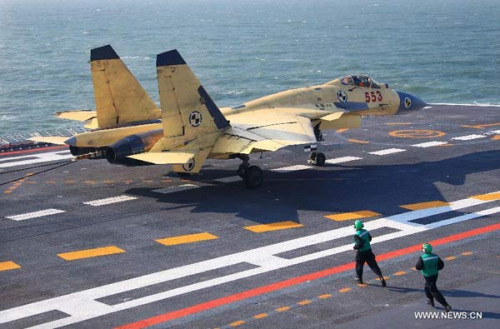
This undated photo shows a carrier-borne J-15 fighter jet landing on China's first aircraft carrier, the Liaoning. China has successfully conducted flight landing on its first aircraft carrier, the Liaoning. After its delivery to the People's Liberation Army (PLA) Navy on Sept. 25, the aircraft carrier has undergone a series of sailing and technological tests, including the flight of the carrier-borne J-15. Capabilities of the carrier platform and the J-15 have been tested, meeting all requirements and achieving good compatibility, the PLA Navy said. Designed by and made in China, the J-15 is able to carry multi-type anti-ship, air-to-air and air-to-ground missiles, as well as precision-guided bombs. The J-15 has comprehensive capabilities comparable to those of the Russian Su-33 jet and the U.S. F-18, military experts estimated. (Xinhua/Zha Chunming)
Foreign media reports have claimed that China's new J-15 carrier-borne fighter jet is merely a copy of a Russian model. Such an assertion is groundless and sour.
The J-15 made its debut in a landing and take-off exercise on China's aircraft carrier, the Liaoning, last weekend.
Chinese people hailed the successful test that makes the country one of the few around the world to operate carrier-borne jets.
It is not surprising that some western media quickly responded to the inspiring news with criticism and taunts, since the J-15, with an unfinished coating during the exercise had a similar aerodynamic shape with the Russian Su-33 jet.
There is always criticism of China for the crime of "plagiarism" when the country makes progress in military hardware development, questioning China's respect to others' intellectual property rights and belittling the hardware's technological and tactical qualities.
The criticism is also not surprising because China has often achieved progress within a much shorter period of time than what it usually has taken some western countries to do.
It is true that China used to rely heavily on imported Russian military aircraft, warships and other hardware to modernize its troops due to a lack of independent innovation abilities.
But people should not use that as an excuse for criticising Chinese people who have made tough endeavors and even sacrifices in developing the J-15's engine, fire-control system, electronics system and other key components.
With years of research and experiment, China has already made breakthroughs in manufacturing home-made turbofan engines which provides high-performance home-made fighter jets with a strong "heart."
On Sunday, chief of the J-15 project Luo Yang died of heart attack on the carrier's voyage return to base after the landing exercise, which gives a mournful example of how hard Chinese scientific personnel have worked under high pressure.
Those with ulterior motives should never underestimate China's capabilities of independent innovation in national defense technologies.
China developed nuclear weapons and artificial satellites when the country was still in poverty and hardship. It has also made significant breakthroughs in a series of key technologies, including the manned space program.
Undoubtedly, the history of mankind is a process of learning from each other, borrowing ideas mutually and developing one's own technologies by absorbing other's advantages.
China has spread its own wisdom and civilization throughout the world such as the "four great inventions," and no one criticized that other countries copied the Chinese.
But some countries have long remained hostile and precautious toward China. They constantly fabricate sayings of "military spy" and "technical plagiarism" and speaking negatively of China with the purpose of extending technological blockade and halting the country's development of advanced military science.
Some military powers also press on curbing China's military progress in order to retain their position as world's top countries in key military technologies.
Therefore China's development in military technologies must rely on self-dependent scientific innovation.
According to President Hu Jintao's report to the 18th National Congress of the Communist Party of China, China will "strengthen the development of new- and high-technology weapons and equipment and enhance the capacity for innovation in defense-oriented research and industries."
Just as Hu's report said, the ultimate objective of China's endeavors to develop military hardware is "to safeguard China's sovereignty, security and territorial integrity and ensure its peaceful development."
China will be more confident and capable to curb war and safeguard world peace and security through peaceful means with its modernization of national defense and its military building stepping forward.

Copyright ©1999-2011 Chinanews.com. All rights reserved.
Reproduction in whole or in part without permission is prohibited.